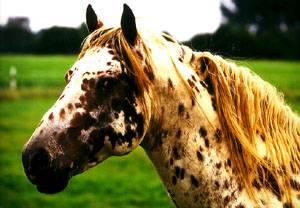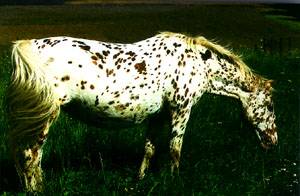Knabstrup Horses
 The Knabstrup originated in Denmark. It traces back to the age of the Vikings.
The Knabstrup originated in Denmark. It traces back to the age of the Vikings.
The original size of the Knabstrup horse was about 14.3 hands. It had clean, dry limbs; large, strong hind quarters; and a small, refined head. Basic qualities included an easy and tractable temperament, and these horses were know for their speed and endurance. Since 1100 A.D. the principal lines of distribution extended rapidly when China opened its borders for trade. The Chinese used spotted horses to transport silk and other articles. Part of their main route crossed through France and Spain, which is interesting as the spotted horses were among the earliest to be taken to the Americas.
The aim in breeding Knabstrup horses today is to preserve the horse as a Danish riding horse, no matter what size. This is unique, because few breeds can present horses in all sizes. Today the Knabstrup is found in both ponies and full-sized horses.
 The Knabstrup has a beautiful, spotted coat, occurring in many colors and variations.
The breed is known for its calmness and friendly temper, intelligence, and aptness
to learn. This horse is frequently used in circuses. Knabstrup horses are strong with
solid dry limbs and strong hooves. The average height is 15.1 to 16 h.h.
The Knabstrup has a beautiful, spotted coat, occurring in many colors and variations.
The breed is known for its calmness and friendly temper, intelligence, and aptness
to learn. This horse is frequently used in circuses. Knabstrup horses are strong with
solid dry limbs and strong hooves. The average height is 15.1 to 16 h.h.
Knabstrup horses have been used in the cavalry, as post and milkwagon horses, and as ordinary riding and work horses. Presently the breed is promoted as a riding and carriage horse. Recently there has been a good deal of crossbreeding and some breeders have concentrated more on color than on conformation. As a result, many different types are represented within the breed and the original type is nearly extinct.
Knabstrup horses are beginning to make themselves known in the show ring and in competitive sports.
Population Status: Rare
References
Hendricks, Bonnie L., International Encyclopedia of Horse Breeds, Univ of Oklahoma Press, 1995.
